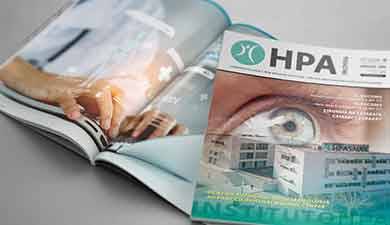Enf.º Alain Delgado
Nurse Specialist in Maternal Health and Obstetrics

Absolute bed rest versus relative rest in pregnancies when there is a risk of preterm birth
HPA Magazine 11
Maternidade
The birth of a new baby is a very important event in any couple´s life. It is a time to prepare for the pregnancy, for the birth, and naturally to welcome a new member of the family.
However, sometimes plans are altered when there is a threat of childbirth before pregnancy reaches the end of the 37th week.
Faced with the threat of pre-term labour, the pregnant woman is admitted to hospital by the obstetrician for surveillance and treatment.

The birth of a new baby is a very important event in any couple´s life. It is a time to prepare for the pregnancy, for the birth, and naturally to welcome a new member of the family.
However, sometimes plans are altered when there is a threat of childbirth before pregnancy reaches the end of the 37th week.
Faced with the threat of pre-term labour, the pregnant woman is admitted to hospital by the obstetrician for surveillance and treatment.
The aim is to prevent preterm labour, or at least delay delivery when possible. Another reason for hospital admission is to provide the best conditions possible for pulmonary maturation of the foetus. This maturity is ensured through the administration of corticosteroids (prescribed according to the gestational age) and aims to optimise respiratory functioning at birth.
The administration of tocolytic medication, aims to interrupt uterine contractions, which may be an important factor, but each situation is evaluated by the obstetrician.
Rest is also one of the first instructions of the obstetrician. It is usually prescribed because work or demanding physical activity are risk factors associated with a pre-term labour threat. Rest is aimed at reducing stress, physical burden and uterine contractions, avoiding premature childbirth. The object is to give the foetus more time to develop in the uterine.
The type of rest prescribed may be divided into absolute rest or relative rest.
In absolute bed rest, physical activity is reduced to a minimum; the pregnant woman must lie in bed at all the times and cannot leave the bed. All necessary activities such as meals, hygiene and toilet necessities, must be carried out in bed.
In relative rest, the pregnant woman may leave the bed in moderation, to go to the bathroom for personal hygiene and to use the toilet. Mobility is, however, restricted to the essential minimum, and therefore she cannot wonder freely out of bed. These rest indications may last for several days or weeks, and differ depending on each specific situation.
For a long time, it was thought that absolute bed rest would be essential as a standard measure. However, it is known that continuous physical inactivity also has its risks, even in young people, namely:
- Increased risk of thromboembolism;
- Anxiety and depression;
- Family stress;
- Financial worries;
- Weakening of Muscles and bones;
- Difficulty in postpartum recovery;
- Increased likelihood of complications, in proportion to the imposed movement restriction.
Despite these risks, the option of absolute rest cannot be ruled out, being an important option for the obstetrician in specific situations.
Relative rest option decreases some of these risks, but a severe decrease in mobility is nevertheless required, so the psychological, family, economic and social risk factors will still persist when prolonged hospitalisation is necessary.
As all people are different, the life style, stress levels, and physical activity of pregnant women also vary. Reducing activity and fatigue, providing a calm environment, can be important factors in avoiding pre-mature labour. But this is often not the only cause, and other causes may be responsible.
Due to the risks inherent to immobility, the care team should set up a follow-up strategy, explaining in an enlightening manner the risks involved in a threat of premature childbirth, the benefits of the implemented rest, as well as its risks. The team should also be aware of the risk of thromboembolic alteration, provide psychological and emotional support, involving the family and, if necessary, provide cardiorespiratory and/or neuromusculoskeletal physiotherapy.








